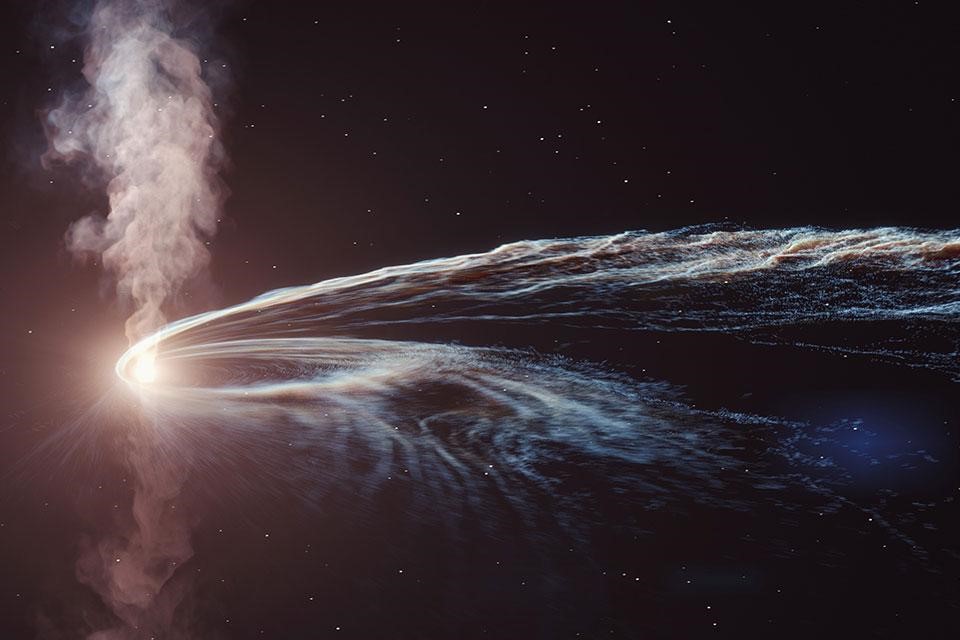Earth’s Foreshock: A Natural Cosmic Particle Accelerator Found
Syllabus:
GS-3:
Scientific Innovations & Discoveries
Focus:
Recent data from NASA’s MMS, THEMIS, and ARTEMIS missions revealed a large-scale energy transfer process in Earth’s foreshock. Scientists discovered that collisionless shock waves in this region accelerate electrons to extreme speeds, solving a long-standing astrophysical mystery about high-energy cosmic particle acceleration.
Understanding a Cosmic Mystery Unveiled:
- Scientists have long been puzzled by how subatomic particles like electrons gain ultra-high energy in space.
- Recent data from three NASA space missions (MMS, THEMIS, ARTEMIS) in 2017 provided new insights.
- A transient large-scale phenomenon was observed in Earth’s foreshock region (ahead of the bow shock).
- Electrons appeared to acquire energy levels much higher than previously recorded, leading to a new understanding of space particle acceleration.
The Role of Collisionless Shock Waves in Particle Acceleration:
Understanding Shock Waves
- Shock waves occur when energy is transferred faster than the speed of sound in a medium.
- Unlike in solids, liquids, or gases, where particles collide to transfer energy, in plasma, particles interact via electromagnetic forces
- These collisionless shock waves are known to exist throughout the universe and play a crucial role in accelerating particles.
Importance of Plasma in Space
- Plasma, a gas of charged particles, is the fourth state of matter and can conduct electricity.
- It is present in numerous cosmic environments, including black hole accretion disks, pulsars, magnetars, and supernovae remnants.
- The new study highlights how shock waves within plasma may act as powerful cosmic particle accelerators.
The Electron Injection Problem and Diffusive Shock Acceleration:
Diffusive Shock Acceleration (DSA) Mechanism
- DSA is a well-known process that explains how particles gain ultra-high speeds through repeated interactions with shock waves.
- However, it requires electrons to already be moving at 50% of the speed of light before further acceleration can occur.
The Long-Standing Mystery: How Do Electrons Get the Initial Boost?
- Scientists have debated for years whether a natural process in space could provide this initial acceleration.
- This question is called the “electron injection problem” in astrophysics.
New Findings Addressing the Mystery
- The NASA data revealed electrons in Earth’s foreshock acquiring more than 500 keV of energy, moving at 86% the speed of light.
- This was significantly higher than the typical 1 keV energy found in this region.
- The researchers found that these high-energy electrons resulted from a complex interplay of multiple acceleration mechanisms.
The Role of Earth’s Magnetosphere and Solar Wind:
Understanding the Bow Shock and Foreshock
- The bow shock is the region where the solar wind (a stream of charged particles from the sun) meets Earth’s magnetosphere.
- The foreshock is the leading area of the bow shock, where electrons interact with electromagnetic forces.
How the Solar Wind Contributes to Particle Acceleration
- When solar wind hits the magnetosphere, it slows down and transfers energy into the bow shock.
- This interaction produces shock waves, which can accelerate particles to extreme speeds.
- The data revealed a previously unknown large-scale energy transfer process occurring in the foreshock region.
Excluding Other Potential Causes
- The researchers ruled out influences from solar flares and coronal mass ejections as sources of these high-energy electrons.
- Instead, they identified interactions with plasma waves and transient shock structures as the key factors.
Implications for Cosmic Physics and Future Research:
Connection to Cosmic Rays and High-Energy Particles
- Cosmic rays are streams of high-energy particles that travel through the universe and interact with Earth’s atmosphere.
- The study suggests that collisionless shock waves might be responsible for a portion of cosmic ray acceleration.
Potential Applications Beyond Earth
- The researchers propose that similar mechanisms may exist in other stellar and planetary systems.
- For example, in systems where gas giants orbit close to stars, massive magnetic fields may enable the same acceleration process.
A Call for Further Research
- The study invites collaboration between stellar astrophysicists and particle acceleration researchers.
- More observations and simulations are needed to confirm whether this mechanism contributes significantly to cosmic ray formation across the universe.
Conclusion: A Breakthrough in Astrophysics
- The discovery of extreme particle acceleration in Earth’s foreshock sheds new light on cosmic phenomena.
- It provides a potential solution to the electron injection problem, a long-standing astrophysical mystery.
- This research enhances our understanding of how energy is transferred in space plasmas and its role in shaping cosmic events.
- Future space missions and observations will be crucial in expanding our knowledge of these high-energy processes and their implications for astrophysics.
Source: TH
Mains Practice Question:
Recent discoveries indicate that Earth’s foreshock region plays a crucial role in accelerating cosmic particles. Discuss the significance of collisionless shock waves in space physics. How can these findings contribute to our understanding of high-energy cosmic rays and their impact on Earth? (Answer in 250 words)




